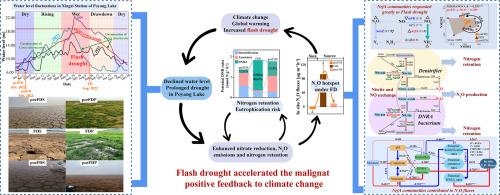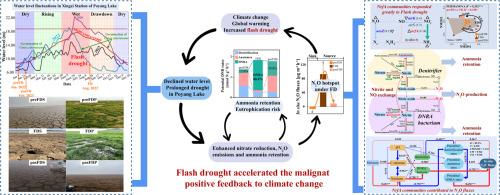在中国最大的淡水湖突发性干旱下,异化硝酸盐还原途径驱动高氧化亚氮排放和氨潴留
IF 12.4
1区 环境科学与生态学
Q1 ENGINEERING, ENVIRONMENTAL
引用次数: 0
摘要
气候变化引起的突发性干旱(FD)事件可能会破坏河漫滩湖泊的正常水文状态,并影响植物-微生物介导的异化硝酸盐还原(DNR),即反硝化、厌氧氨氧化和异化硝酸盐还原成氨(DNRA),从而对氧化亚氮(N2O)排放和氨保留产生重要影响。然而,对于2022年中国长江河漫滩湖泊DNR路径对破纪录FD的响应,以及潜在的微生物机制和对气候变化的反馈,人们仍然知之甚少。在此,我们收集了2022年FD期间鄱阳湖滨海湿地的暴露沉积物和苔草相关土壤,以及该事件前后的旱季。利用15N同位素配对技术、高通量和宏基因组测序技术研究了潜在的DNR率和参与DNR的微生物群落的协同代谢。研究发现,在暴发性干旱期间,滨海湿地的原位N2O通量最高,特别是暴露的沉积物。在暴发性干旱条件下,潜在的DNRA率最高,在暴露沉积物(80.4%)和苔草相关土壤(57.5%)中,DNRA占主导地位。营养物(即N和P)和DNRA细菌群落在暴露沉积物中产生极高的N2O通量中发挥了关键作用,这可以解释为DNRA细菌和反硝化菌通过DNR中关键中间体的交换进行协同代谢。因此,气候变化引发的突发性干旱导致鄱阳湖滨海湿地氧化亚氮排放和氨潴留增加,温室气体排放通量增大,湖泊富营养化风险增大。因此,突发性干旱加强了气候变暖和这些水生生态系统的一氧化二氮排放之间的正反馈。本文章由计算机程序翻译,如有差异,请以英文原文为准。


Dissimilatory nitrate reduction pathways drive high nitrous oxide emissions and nitrogen retention under the flash drought in the largest freshwater lake in China
Flash drought (FD) events induced by climate change may disrupt the normal hydrological regimes of floodplain lakes and affect the plant-microbe mediated dissimilatory nitrate reduction (DNR), i.e., denitrification, anammox and dissimilatory nitrate reduction to ammonium (DNRA), thus having important consequences for nitrous oxide (N2O) emissions and nitrogen (N) retention. However, the responses of the DNR pathways in the floodplain lake to the record-breaking FD in 2022 in Yangtze River of China, as well as the underlying microbial mechanisms and feedbacks to climate change remain poorly understood. Here, we collected exposed sediments and Carex cinerascens–associated soils in the littoral wetlands of Poyang Lake during 2022 FD and the dry seasons prior to and after this event. The potential DNR rates and the synergistic metabolism of microbial guilds involved in DNR were investigated using 15N isotope pairing technique, high-throughput and metagenomic sequencing. We found that the in situ N2O fluxes in the littoral wetlands were highest during the flash drought, especially in the exposed sediments. The potential DNRA rates were highest under flash drought conditions, and DNRA dominated the DNR for both exposed sediments (80.4 %) and Carex cinerascens-associated soils (57.5 %). Nutrients (i.e., N and P) and DNRA bacterial communities played a key role in producing the extremely high N2O fluxes from exposed sediments, which could be explained by the synergistic metabolism of DNRA bacteria and denitrifiers through the exchange of the key intermediates in DNR. Therefore, the climate change–induced flash drought promoted greater nitrous oxide emissions and N retention in the littoral wetlands of Poyang Lake, producing a greater flux of greenhouse gas emissions and elevating the risk of lake eutrophication. Hence, flash droughts reinforce a positive feedback between climate change and nitrous oxide emission from these aquatic ecosystems.
求助全文
通过发布文献求助,成功后即可免费获取论文全文。
去求助
来源期刊

Water Research
环境科学-工程:环境
CiteScore
20.80
自引率
9.40%
发文量
1307
审稿时长
38 days
期刊介绍:
Water Research, along with its open access companion journal Water Research X, serves as a platform for publishing original research papers covering various aspects of the science and technology related to the anthropogenic water cycle, water quality, and its management worldwide. The audience targeted by the journal comprises biologists, chemical engineers, chemists, civil engineers, environmental engineers, limnologists, and microbiologists. The scope of the journal include:
•Treatment processes for water and wastewaters (municipal, agricultural, industrial, and on-site treatment), including resource recovery and residuals management;
•Urban hydrology including sewer systems, stormwater management, and green infrastructure;
•Drinking water treatment and distribution;
•Potable and non-potable water reuse;
•Sanitation, public health, and risk assessment;
•Anaerobic digestion, solid and hazardous waste management, including source characterization and the effects and control of leachates and gaseous emissions;
•Contaminants (chemical, microbial, anthropogenic particles such as nanoparticles or microplastics) and related water quality sensing, monitoring, fate, and assessment;
•Anthropogenic impacts on inland, tidal, coastal and urban waters, focusing on surface and ground waters, and point and non-point sources of pollution;
•Environmental restoration, linked to surface water, groundwater and groundwater remediation;
•Analysis of the interfaces between sediments and water, and between water and atmosphere, focusing specifically on anthropogenic impacts;
•Mathematical modelling, systems analysis, machine learning, and beneficial use of big data related to the anthropogenic water cycle;
•Socio-economic, policy, and regulations studies.
 求助内容:
求助内容: 应助结果提醒方式:
应助结果提醒方式:


